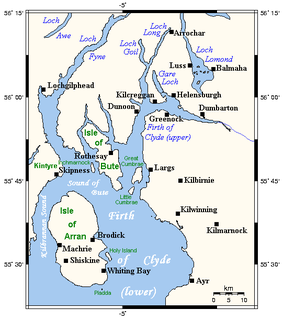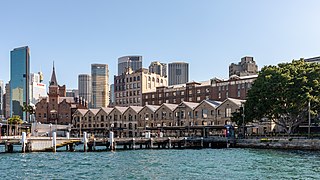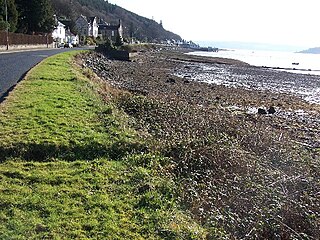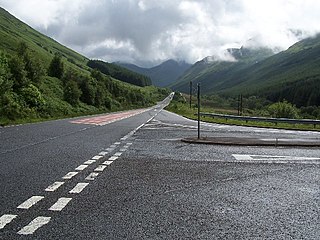
In the United Kingdom, a scheduled monument is a nationally important archaeological site or historic building, given protection against unauthorised change.

The Firth of Clyde is the mouth of the River Clyde. It is located on the west coast of Scotland and constitutes the deepest coastal waters in the British Isles. The firth is sheltered from the Atlantic Ocean by the Kintyre peninsula, which encloses the outer firth in Argyll and Ayrshire. The Kilbrannan Sound is a large arm of the Firth of Clyde, separating the Kintyre Peninsula from the Isle of Arran. Within the Firth of Clyde is another major island – the Isle of Bute. Given its strategic location at the entrance to the middle and upper Clyde, Bute played a vital naval military role during World War II.

Dunoon is the main town on the Cowal peninsula in the south of Argyll and Bute, Scotland. It is located on the western shore of the upper Firth of Clyde, to the south of the Holy Loch and to the north of Innellan. As well as forming part of the council area of Argyll and Bute, Dunoon also has its own community council. Dunoon was a burgh until 1976.

Gourock is a town falling within the Inverclyde council area and formerly forming a burgh of the County of Renfrew in the west of Scotland. It has in the past functioned as a seaside resort on the East shore of the upper Firth of Clyde. Its principal function today, however, is as a popular residential area, extending contiguously from Greenock, with a railway terminus and ferry services across the Clyde.

The Rocks is a suburb, tourist precinct and historic area of Sydney's city centre, in the state of New South Wales, Australia. It is located on the southern shore of Sydney Harbour, immediately north-west of the Sydney central business district.

Hunters Hill is a suburb of the lower north shore of Sydney, in the state of New South Wales, Australia. Hunters Hill is located 9 kilometres (5.6 mi) north-west of the Sydney central business district and is the administrative centre for the local government area of the Municipality of Hunter's Hill.

Pitt Street is a major street in the Sydney central business district in New South Wales, Australia. The street runs through the entire city centre from Circular Quay in the north to Waterloo, although today's street is in two disjointed sections after a substantial stretch of it was removed to make way for Sydney's Central railway station. Pitt Street is well known for the pedestrian only retail centre of Pitt Street Mall, a section of the street which runs from King Street to Market Street.

George Street is a street in the central business district of Sydney.

The Sydney central business district (CBD) is the historical and main commercial centre of Sydney. The Sydney CBD is Sydney's city centre, or Sydney City, and the two terms are used interchangeably. The CBD or city centre is often referred to simply as "Town" or "the City". The Sydney city centre extends southwards for about 3 km (2 mi) from Sydney Cove, the point of first European settlement in which the Sydney region was initially established. Due to its pivotal role in Australia's early history, it is one of the oldest established areas in the country.

Kilmun is a linear settlement on the north shore of the Holy Loch, on the Cowal peninsula in Argyll and Bute, Scottish Highlands.It takes its name from the 7th century monastic community founded by an Irish monk, St Munn. The ruin of a 12th-century church still stands beside the Kilmun Parish Church and Argyll Mausoleum.

Strone is a village on the Cowal peninsula in Argyll and Bute in the Scottish Highlands at the point where the north shore of the Holy Loch becomes the west shore of the Firth of Clyde. The village lies within the Loch Lomond and The Trossachs National Park.

Kirn is a village in Argyll and Bute in the Scottish Highlands on the west shore of the Firth of Clyde on the Cowal peninsula. It now forms part of the continuous habitation between Dunoon and Hunters Quay, where the Holy Loch joins the Firth of Clyde. It originally had its own pier, with buildings designed by Harry Edward Clifford in 1895, and was a regular stop for the Clyde steamer services, bringing holidaymakers to the town, mostly from the Glasgow area.

The A815 is a major road in Argyll and Bute, Scotland. It runs for about 37 miles (60 km) from Toward in the south to the A83, near Cairndow, in the north.

Hunters Quay is a village, on the Cowal peninsula in Argyll and Bute, Scottish Highlands. Situated between Kirn to the south and Ardnadam to the north, Hunters Quay is the main base of Western Ferries, operating between Hunters Quay and McInroy's Point.

Aberdeen Harbour, rebranded as the Port of Aberdeen in 2022, is a sea port located in the city of Aberdeen on the east coast of Scotland. The port was first established in 1136 and has been continually redeveloped over the centuries to provide a base for significant fishing and ship building industries. Since the 1970s it has provided support to the offshore oil and gas industry operating in the North Sea and it is the main commercial port in the north east of Scotland.

The Royal Marine Hotel is a hotel located on Marine Parade in Hunters Quay, Argyll and Bute, Scotland. It is a Category B listed building, opened in 1890 after the original 1856 building, named Marine Hotel, was gutted by fire. Its architect was Glasgow's Thomas Lennox Watson. The new construction received royal patronage in 1872.

The Queen's Hotel was a hotel located on Marine Parade in Kirn, Argyll and Bute, Scotland. Now a private residence, it is a Category C listed building, dating to around 1859. Its first proprietor was Mrs Urquhart.

Kirn & Sandbank Parish Church is a Church of Scotland church building in Kirn, Argyll and Bute, Scotland. It also serves the population of nearby Sandbank. The church is located on Kirn Brae at its junction with Marine Parade, which leads to and from Dunoon, about a mile to the southwest. Constructed in the Romanesque style, it is a Category B listed building.

Hafton House is a Category B listed country house in Hunters Quay, Argyll and Bute, Scotland. The property is located on the southern shores of the Holy Loch. It dates to the late 18th century, built to a design by David Hamilton, and it received its historic designation in 1971. It is two storeys, with a higher tower.

Dunoon Pier is a Victorian pier in the Scottish town of Dunoon, Argyll and Bute. Completed in its current form in 1898, and reaching out into the Firth of Clyde, its earliest parts date back to 1835. It is now a Category A listed structure and, according to Historic Environment Scotland, the best surviving example of a timber ferry pier in Scotland.





















